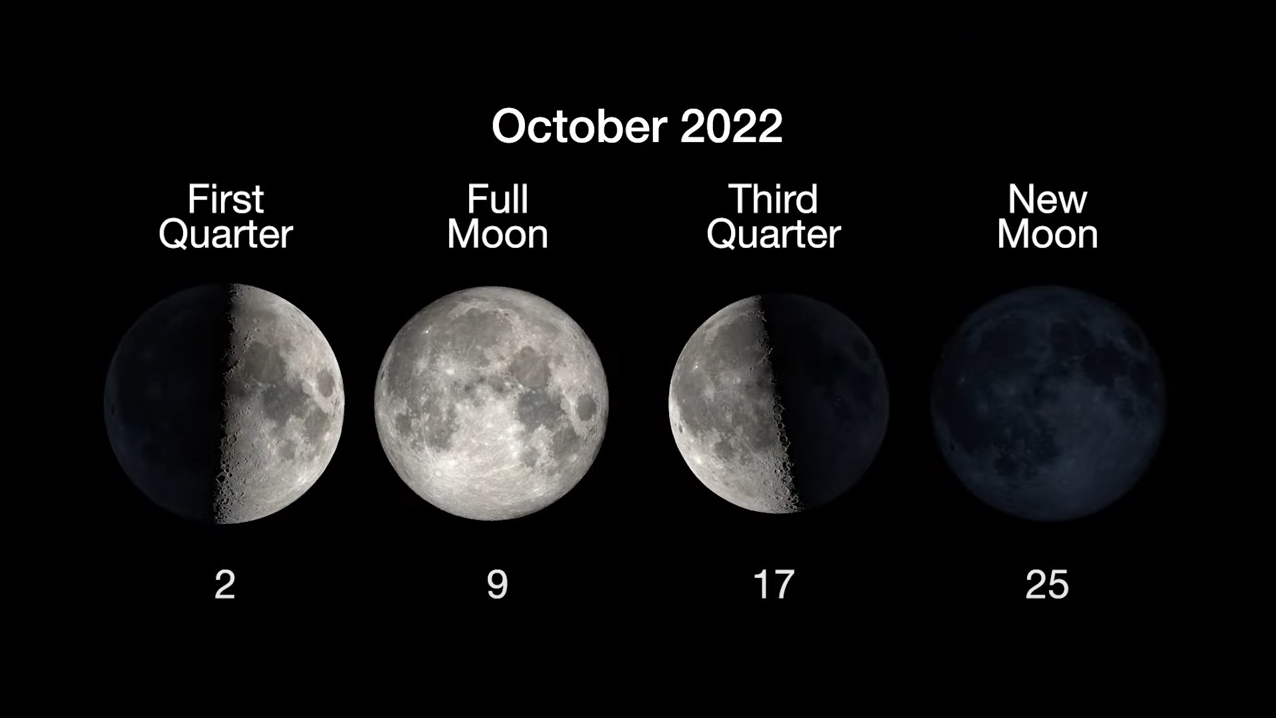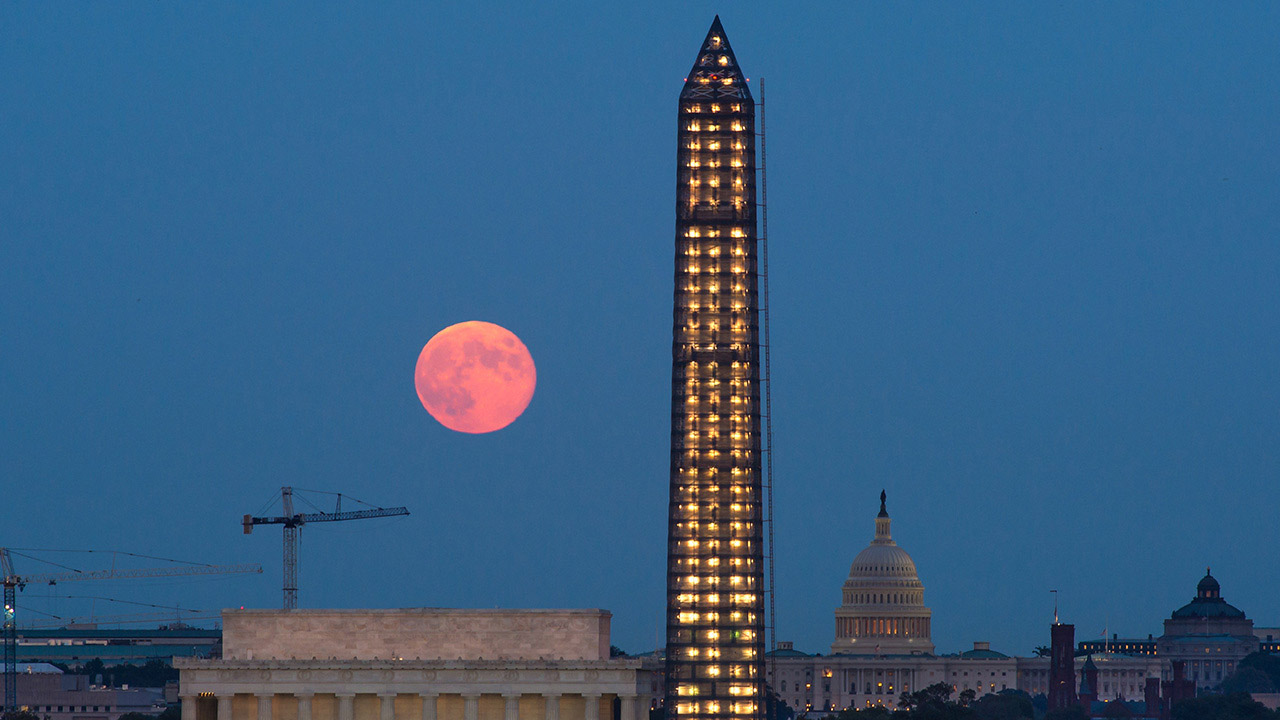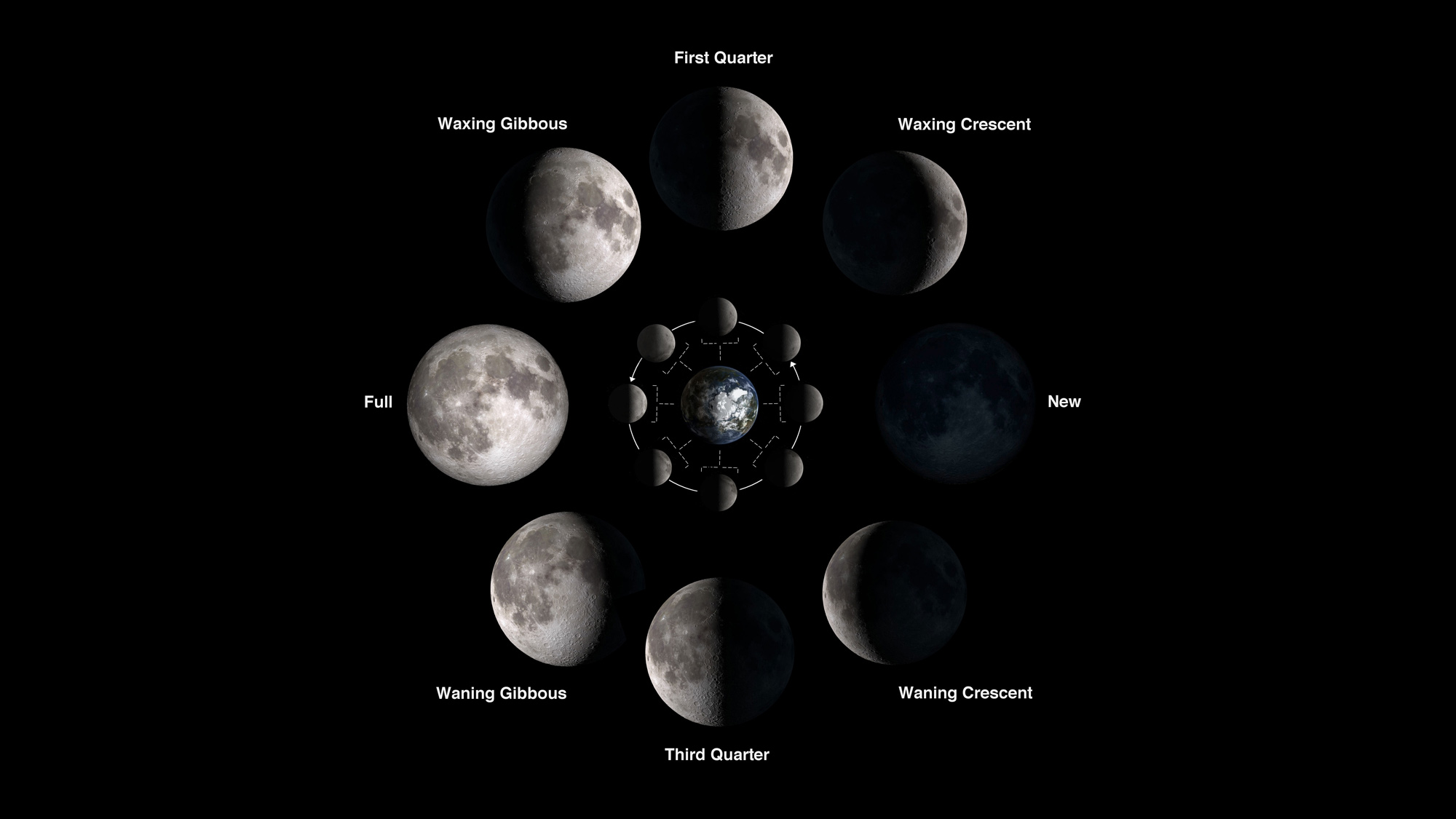As the Moon Continues Every Month
What is the moon phase today? Lunar phases 2022
This page was updated on Oct. 21, 2022.

Today, Oct. 21, 2022, the moon is 26 days old and is in the Waning Crescent moon phase of its lunar cycle. It is 16% illuminated. In October 2022, the moon's phases occur on these days:
First Quarter: Oct. 2
Full Moon: Oct. 9
Last Quarter: Oct. 17
New Moon: Oct. 25
Moon phases reveal the passage of time in the night sky. Some nights when we look up at the moon, it is full and bright; sometimes it is just a sliver of silvery light. These changes in appearance are the phases of the moon. As the moon orbits Earth, it cycles through eight distinct phases.
The four primary phases of the moon occur about a week apart, with the full moon its most dazzling stage. Check out amazing photos of the Harvest Moon of 2022 from observers around the world last month on Sept. 10!

Tariq is the Editor-in-Chief of Space.com and joined the team in 2001. He covers skywatching, human spaceflight, exploration as well as space science and entertainment, and enjoys observing the moon through a tabletop Celestron telescope when the weather is clear.
What's the moon phase tonight?
While the moon has four distinct phases each month, it is always changing.
As you observe the moon during the month, watch as it grows from a new moon to a first quarter moon. As it grows, it is known as a waxing moon, and gradually increases from a waxing "crescent" (for its shape into the first quarter moon. As it continues to brighten, it takes on an oblong, or "gibbous," shape until it reaches the full moon stage.
Then it will repeat the steps in reverse as it heads back to a new moon. You can see what today's moon phase is here with the embedded widget on this page, courtesy of In-The-Sky.org (opens in new tab).
What is the next moon phase?

After the last quarter moon on Oct. 17 at 1:15 p.m. EDT (1715 GMT). The next moon phase milestone will be the New Moon on Oct. 25 at 6:49 a.m. EDT (1049 GMT).
The new moon is the so-called "invisible phase of the moon," according to NASA (opens in new tab), because the illuminated side of the moon is facing away from Earth, toward the sun. The moon is also in the sky during the day, and without its Earth-facing side illuminated by the sun, observers can't really see it.
Occasionally, the moon's orbit does bring it directly between the Earth and the sun during a new moon, causing a solar eclipse or, even more amazingly, a total solar eclipse. But because the moon's orbit is tilted with respect to the Earth, this alignment does not occur every month.m Earth. What we'll see is only half of the moon (a quarter) that will be illuminated in this phase.
This month the new moon will cause a partial solar eclipse on Oct. 25 that will be visible from parts of Europe, western Asia and northeast Africa. The eclipse will be livestreamed online for those unable to view it in person, you can find out how to watch the last solar eclipse of 2022 in our webcast guide.
Related: Solar eclipses 2022: When, where & how to see them
Moon phase calendar for 2022
Here are the moon phases for 2022, according to NASA's SKYCAL (opens in new tab). Times and dates are in UTC time. If you need equipment for viewing the moon, check out our guide to the best telescopes and the best telescopes for kids.
You can also check out our guide on how to photograph the moon, as well as how to photograph a lunar eclipse for major moon events. There's even a guide on how to photograph a solar eclipse.
If you're looking for imaging gear, our best cameras for astrophotography and best lenses for astrophotography guides can help prepare you for the next lunar sight.
| New Moon | First Quarter | Full Moon | Last Quarter |
|---|---|---|---|
| Jan 2, 1:33 p.m. | Jan. 9, 1:11 p.m. | Jan. 17, 6:48 p.m. | Jan. 25. 8:41 a.m. |
| Feb. 1, 12:46 a.m. | Feb. 8, 8:50 a.m. | Feb. 16, 11:57 a.m. | Feb. 23, 5:32 p.m. |
| March 2, 12:35 p.m. | March 10, 5:45 a.m. | March 18, 3:17 a.m. | March 25, 1:37 a.m.. |
| April 1, 2:24 a.m. | April 9, 2:48 a.m. | April 16, 2:55 p.m. | April 23, 7:56 a.m. |
| April 30 4:28 p.m. | May 8, 8:21 p.m. | May 16, 12:14 a.m. | May 22, 2:43 p.m. |
| May 30, 7:30 a.m. | June 7, 10:48 a.m. | June 14, 7:52 a.m. | June 20, 11:11 p.m. |
| June 28, 10:52 p.m. | July 6, 10:14 p.m. | July 13 2:37 p.m. | July 20,10:18 a.m. |
| July 28, 1:55 p.m. | Aug. 5, 7:06 a.m. | Aug. 11, 9:36 p.m. | Aug. 19, 12:36 a.m. |
| Aug. 27, 4:17 a.m. | Sept. 3, 2:08 p.m. | Sept. 10, 5:59 a.m. | Sept. 17, 5:52 p.m. |
| Sept. 25, 5:54 p.m. | Oct. 2, 8:14 p.m. | Oct. 9,.4:55 p.m. | Oct. 17, 1:15 p.m. |
| Oct. 25, 6:49 a.m. | Nov. 1, 1:37 a.m. | Nov. 8, 6:02 a.m. | Nov. 16, 8:27 a.m. |
| Nov. 23, 5:57 p.m. | Nov. 30, 9:36 a.m. | Dec. 7, 11:08 p.m. | Dec. 16, 3:56 a.m. |
| Dec. 23, 5:17 a.m. | Dec. 29, 8:20 p.m. |
Phases of the moon

(opens in new tab)
The moon, like Earth, is a sphere, and it is always half-illuminated by the sun. As the moon travels around Earth, we see more or less of the illuminated half. Moon phases describe how much of the moon's disk is illuminated from our perspective.
New moon: The moon is between Earth and the sun, and the side of the moon facing toward us receives no direct sunlight; it is lit only by dim sunlight reflected from Earth.
Waxing crescent: As the moon moves around Earth, the side we can see gradually becomes more illuminated by direct sunlight.
First quarter: The moon is 90 degrees away from the sun in the sky and is half-illuminated from our point of view. We call it "first quarter" because the moon has traveled about a quarter of the way around Earth since the new moon.

Waxing gibbous: The area of illumination continues to increase. More than half of the moon's face appears to be getting sunlight.
Full moon: The moon is 180 degrees away from the sun and is as close as it can be to being fully illuminated by the sun from our perspective. The sun, Earth and the moon are aligned, but because the moon's orbit is not exactly in the same plane as Earth's orbit around the sun, they rarely form a perfect line. When they do, we have a lunar eclipse as Earth's shadow crosses the moon's face.
Waning gibbous: More than half of the moon's face appears to be getting sunlight, but the amount is decreasing.
Last quarter: The moon has moved another quarter of the way around Earth, to the third quarter position. The sun's light is now shining on the other half of the visible face of the moon.
Waning crescent: Less than half of the moon's face appears to be getting sunlight, and the amount is decreasing.
Finally, the moon is back to its new moon starting position. Now, the moon is between Earth and the sun. Usually, the moon passes above or below the sun from our vantage point, but occasionally it passes right in front of the sun, and we get a solar eclipse.
Additional moon phase resources
NASA's SkyCal Events Calendar (opens in new tab) offers a comprehensive calendar of moon phases, lunar and solar eclipses and more for the entire calendar year. You can see more about the full moons of 2022, in Space.com's Full Moon Calendar. Our night sky guide has a list of events for skywatching this month.
Bibliography
SkyCal - SkyEvents Calendar, NASA Goddard Spaceflight Center
https://eclipse.gsfc.nasa.gov/SKYCAL/SKYCAL.html
What's Up - Skywatching Tips from NASA
https://solarsystem.nasa.gov/skywatching/whats-up/
Join our Space Forums to keep talking space on the latest missions, night sky and more! And if you have a news tip, correction or comment, let us know at: community@space.com.
Source: https://www.space.com/18880-moon-phases.html
0 Response to "As the Moon Continues Every Month"
Post a Comment